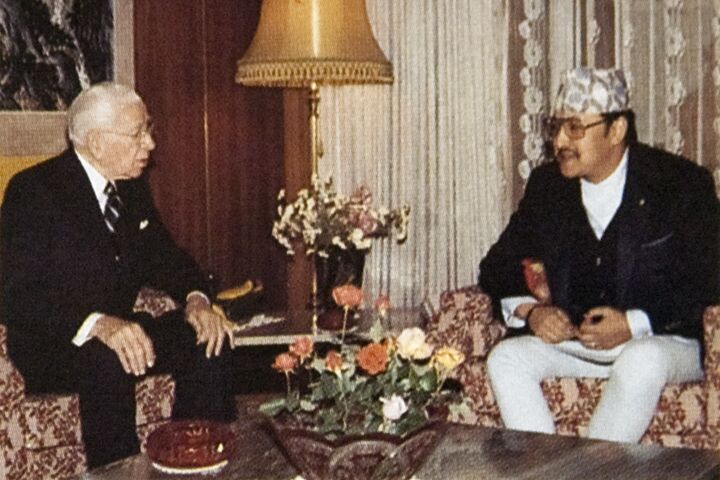
True Education for Nepal
You’re probably not aware that recently, “A court in northwestern Nepal has convicted 19 villagers for the beating deaths of seven people from a rival community in a dispute over foraging for a rare fungus known as ‘Himalayan Viagra’” (Msnbc.com, November 16).
Trouble in the remote tribal villages of the country has been a longstanding problem. However, Nepal once received an honored ambassador for world peace, Herbert Armstrong, who showed the nation’s leaders at the time just how to work to solve the challenges of maintaining community peace. Nepal’s leaders expressed appreciation for his help in educating both Hindus and Buddhists in remote villages in how to solve their conflicts. In fact, the country’s elite were provided the keys to solving their nation’s problems. However, those problems still persist today. As Mr. Armstrong so often said, knowledge is of little use unless it is applied.
On Feb. 27, 1971, Mr. Armstrong wrote to co-workers, “In Nepal I had interviews with both the king and the crown prince. They told me of their insolvable problems of getting education and other help to the isolated mountain people.” Through the Ambassador International Cultural Foundation and cooperation with the king, Mr. Armstrong would later partner in sponsoring mobile schools to aid in education of the rural population.
After the meeting at the king’s palace, Mr. Armstrong went directly to the home of the U.S. ambassador to Nepal, Carol Laise, wife of Ellsworth Bunker, then U.S. ambassador to Vietnam.
Mr. Armstrong recalled an incident that occurred during this reception. “On learning that we had just come from meetings with the king, and with the crown prince the evening before—following meetings with President Giri of India, and Prime Minister Golda Meir of Israel—and on the previous trip with Prime Minister Indira Gandhi of India—at which time King Leopold was traveling with us—and that two days later we were to have a private meeting with the king of Thailand (Siam)—this government official looked puzzled, and asked, ‘Well how in the world do you do it? We’ve been trying for six months to arrange meetings with some of these people, and yet we haven’t been able.’ And they had the power and prestige of the U.S. government!” (co-worker letter, May 28, 1971). Of course, it was not any man opening these doors to preach the gospel message to the world, but the highest of all powers.
Thirteen years later, Mr. Armstrong would be back in Nepal on what would be his final visit. “We came from Nepal, where I had another meeting with King Birendra and Queen Aishwarya in the palace at Kathmandu, Nepal’s capital. Nepal is in the Himalaya mountains with Mt. Everest and other peaks almost the same fantastic height” (ibid, Nov. 18, 1984).
A dinner, the Oberoi Banquet, was hosted in Mr. Armstrong’s honor and he was duly introduced to the special guests as a seeker of peace in the world. He told those assembled that evening:
They have called me an unofficial ambassador for world peace, and so I am. But let me say that there has to be a reason why we don’t have peace. You cannot have peace unless there is something that is going to cause that peace. And there has to be a reason why something has caused us to have just the opposite of peace in this world today, and I am afraid so many don’t understand that.
Now in the world today, there are many different ideologies, philosophies and religions, and everybody seems to think that their own is the right one and the only one that is true and correct. And I did not come to bring any philosophy, or ideology, but just to state a few facts, that are facts. We do not have peace and will not have peace until human nature is changed. … Now I am not going out to crusade and stop all wars, I can’t do that. … And there is no man on Earth who can. It is only the great Creator who can. And it’s because we do not rely on the Creator for the knowledge of how to live and how to do, and because we just look to ourselves, that we find we’re helpless before our problems. The world does not know how to live, because it does not rely on the great Creator who is above all the gods and above all that is worshiped, above all the ideas of human beings. But most human beings don’t know that God.
So respected was this man of God who carried with him the Matthew 24:14 gospel message of coming peace, that the Nepalese royalty was moved with grief upon hearing of their beloved friend’s death, sending the message: “The Queen and I are grieved to hear of the sad demise of Herbert Armstrong. He was a man truly dedicated to the cause of serving humanity. May his soul rest in peace. Birendra Bir Bikram Shah Dev, King of Nepal.”
Twenty-five years later, Herbert Armstrong’s warning has gone largely unheeded as evidenced by the recent arrests in northwestern Nepal. The plain fact is that mankind’s failure to obey their creator and His loving law has resulted not only in lawlessness in Nepal, but lawlessness on a global scale (2 Timothy 3:1-5; Isaiah 3).
Yet, today, you can still learn those same lessons as expounded by Herbert Armstrong to a multitude of world leaders in his lifetime. The Trumpet is but one arm of the continuance of a global work that builds on his legacy. It is impacting the lives of thousands scattered around the globe. It’s a work that carries the same message as Herbert Armstrong did—a message about the only way to true peace and happiness.
